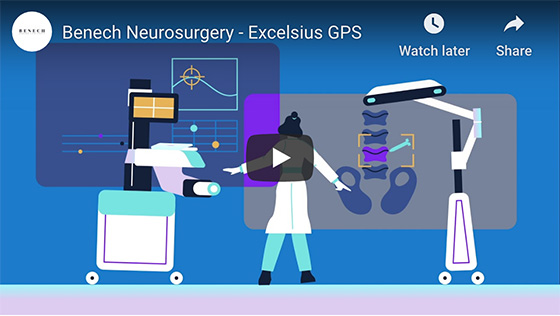Your Spine and ExcelsiusGPS™
ExcelsiusGPS™ is the next revolution in robotic spine surgery from Globus Medical, the developer of spinal and orthopaedic implants and surgical instruments for patients with spinal disorders.
How does ExcelsiusGPS™ work?
ExcelsiusGPS™ is used in spine procedures such as screw and rod fixation, inserted from the back of your spine. On the day of surgery, medical images like X-rays are taken and imported into ExcelsiusGPS™. These images are used by your surgeon to determine the size and placement of screws. Your surgeon creates a surgical plan based on your anatomy. The surgical plan guides the rigid robotic arm to a specific region of your spine, similar to a planned route or pathway on a GPS. The surgeon uses this pathway or route to place screws with a high level of accuracy using surgical instruments (tools) that the surgeon controls.
Throughout the procedure, the surgical instruments and implants are continuously displayed on the screen for the surgeon and staff to monitor. This display allows the surgeon to view live feedback during your procedure.
What is MIS Spine Surgery?
A minimally invasive surgery (MIS) is one in which a small incision is used and muscles are separated rather than split during surgery.
It is important to understand that surgery is unique to each patient and their symptoms. Discuss with your physician if an MIS technique is right for you.
The potential benefits of MIS surgery may include:
- Small incision1 – the surgeon typically operates through small incisions along the spine
- Less tissue damage2 – the surgeon is able to separate muscles surrounding the spine rather than cutting through them
- Shorter hospital stay2 – less tissue damage and smaller incisions may lead to a shorter hospital stay and quicker path to recovery
Frequently Asked Questions
Robotic surgery may be considered a safer method than conventional spine surgery because it helps increase screw placement accuracy compared to conventional techniques.4
Robotic guidance provides assistance to your surgeon. The robotic arm aligns to a trajectory that is preplanned by your surgeon to help guide the surgeon's placement of screw implants using surgical tools. Navigation is a way for your surgeon to see the surgical tools in relation to your body on a screen as they are being used.
What sets ExcelsiusGPS™ apart from other surgical robots is that surgeons can track patient movement on the table, allowing surgeons to make real-time adjustments during surgery to help ensure they stay on the pre-planned pathway.
No. The surgeon is in control of the surgical procedure 100% of the time. ExcelsiusGPS™ robotic navigation basically serves as an additional tool to help surgeons view and place screws according to their planned trajectory.
ExcelsiusGPS™ may be utilized for a variety of spine procedures, including spinal fusion with posterior screw and rod fixation, transforaminal lumbar interbody fusion (TLIF), lumbar lateral interbody fusion (LLIF), sacroiliac (SI) fusion, posterior cervical fixation, deformity correction, revision surgery, and more.
ExcelsiusGPS™ is designed to assist surgeons in cranial procedures by guiding cranial instruments according to the surgeon's preplanned pathway during procedures such as shunt procedures, deep brain stimulation (DBS), biopsies, and stereoelectroencephalography (SEEG).
On the day of surgery, medical images are taken and imported into ExcelsiusGPS™. These images are used by your surgeon to determine the size and placement of implants and to create a surgical plan based on your anatomy. The surgical plan then guides the rigid robotic arm to the specific region where your surgery is planned, so the surgeon can place the screws at planned locations.
Recovery time varies between patients. Patients may notice improvement of some or all symptoms and pain from surgery may diminish 2 to 4 weeks after surgery. It is the surgeon’s goal for you to return to your normal activities as soon as possible. A positive attitude, reasonable expectations, and compliance with post-surgery instructions may all contribute to a satisfactory outcome.
Have other questions about robot-assisted surgery? Please contact us.
1 O’Toole J. Surgical site infection rates after minimally invasive spine surgery. J Neurosurg Spine 2009; 11: 471-476.
2 Tian N F et al. Minimally invasive versus open transforaminal lumbar interbody fusion: a meta-analysis based on the current evidence. Euro Spine J 2013; 22: 1741-1749.
3 Narain AS, Hijji FY, Duhancioglu G, Haws BE, Khechen B, Manning BT, Colman MW, Singh K. Patient Perceptions of Minimally Invasive Versus Open Spine Surgery. Clin Spine Surg. 2018 Apr;31(3):E184-E192. doi: 10.1097/BSD.0000000000000618. PMID: 29465423.
4 Vaccaro, A.R., et al., Assessment of surgical procedural time, pedicle screw accuracy, and clinician radiation exposure of a novel robotic navigation system compared with conventional open and percutaneous free hand techniques: a cadaveric investigation. Global Spine Journal, 2020. 10(7):814-825.
Seeing is believing!
Discover the amazing surgical accuracy of ExcelsiusGPS™ through exploring our library of published scientific papers.

